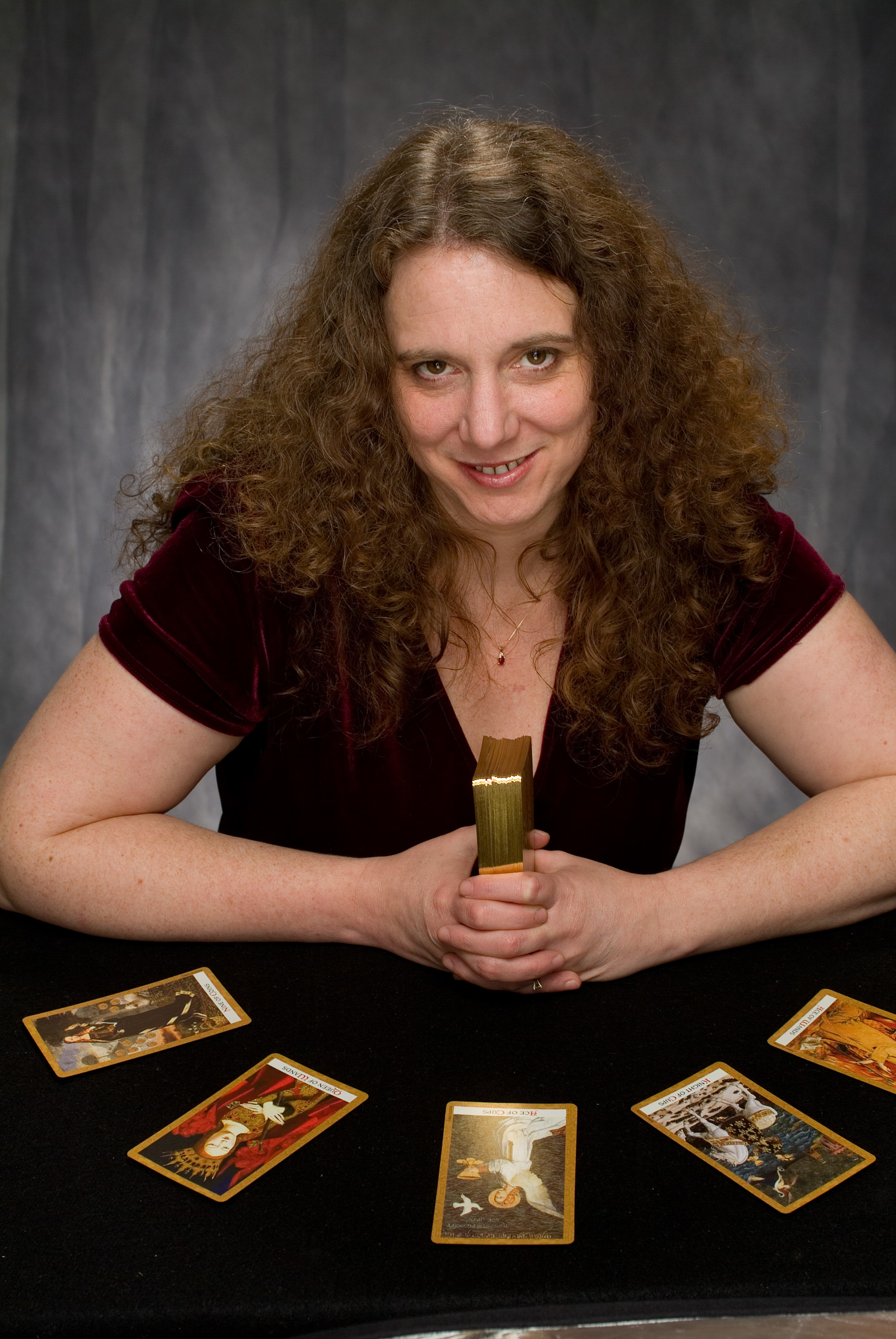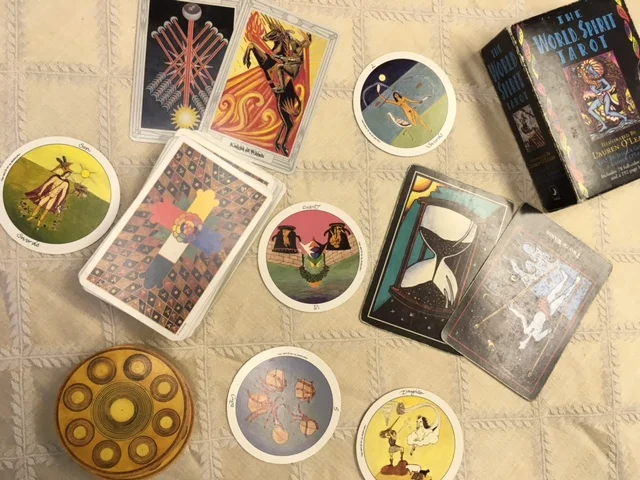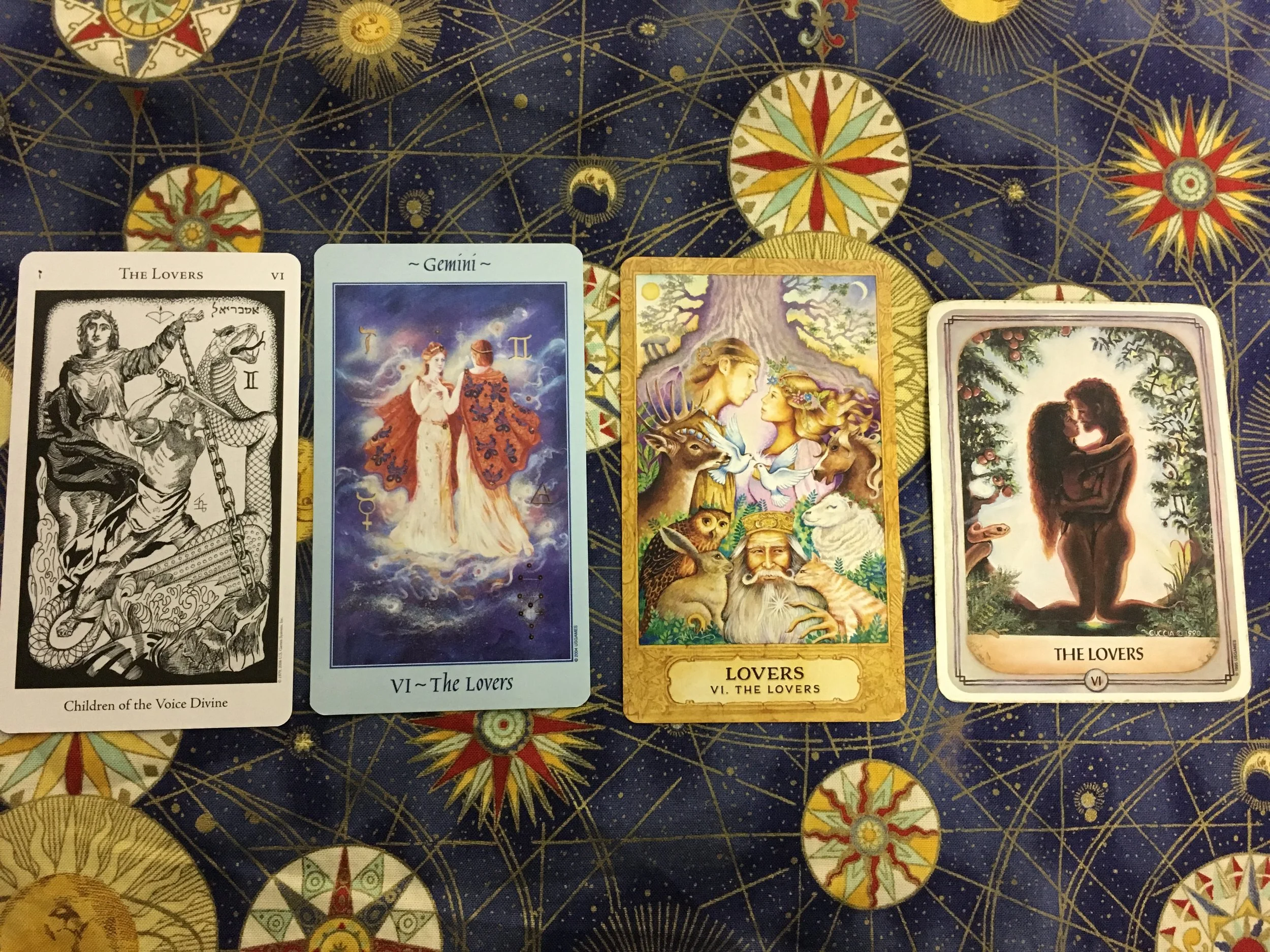
Welcome to my personal blog.
Here you will find my musings, thoughts and observations, all inspired by my experiences as a full-time professional tarot reader.
Reversals, Dignities and the Continuum of a Card
This month, the Tarot Rebels Blog Hop is writing about tarot reversals. I have a lot to say!
I’m blog-hopping with the Tarot Rebels again. This month, our meaty topic is reversals, about which I have much to say.
To read what other bloggers have to say on the topic, follow the link in the graphic at the end of this post!
I’m excited for the opportunity to share why I use reversals, how I interpret reversals, and why dignities matter, even if a reader chooses not to honor reversals.
Some decks, most significantly the Crowley-Harris-Thoth, specifically are not designed to work with reversals.
Rebel that I am, I will consider reversed cards even when reading with such a deck.
I love the energy, magick, possibilities and nuances of reversals so much that, secretly, I feel like readers who don’t honor reversals might be missing an opportunity.
There. That’s my dirty secret.
I absolutely honor each reader’s unique reading style, and recognize that reversals are not mandatory to give a great reading or deliver a sacred message. BUT, deep in my heart, I always secretly wonder if a refusal to use reversals might limit the scope and breadth of the reading.
That’s because reversals add so much to my readings. Truth is, we have other ways of adding texture to our stories. Card dignities and aspects are real, whether we use reversed cards to denote them, or not.
Dignities, or “aspects”, describe the energy with which a card should be read. A “well-dignified” or
“well-aspected” card’s energy is interpreted as directly as possible. If a card is poorly aspected, or ill-dignified, we might see a delay, a resistance, an opposite, or a release. The poor aspect might advise us not to take the action the well-dignified card would advise. The ill-dignity might put the event or action of the card in the past.
I use card orientation (reversals) as a primary way of determining dignity. If one doesn’t honor reversals, dignity is determined using the rigorous system of Elemental Dignities, or by more fluid and intuitive methods.
We might consider the context of the question and the surrounding cards when determining the directness with which we will interpret a card. The nature of the position within a spread plays, too. For instance, a “crossing” or “challenge” position always requires us to look for the shadow side of the card that appears within it.
Some readers use only intuition to decide if they are seeing the gift within a card, or its shadow; whether the card should be read directly, or in a more nuanced way. I would argue that we all do this, regardless of any more mechanical means we might use to denote dignity in a reading.
You can tell a reversals enthusiast by the way we shuffle. Readers who don’t use reversals shuffle in ways that try to avoid reversing cards. I riffle, and purposely turn half the deck around before each riffle, to make sure the Universe has the opportunity to add reversals to the language of tarot when needed.
My love of reversals may have begun with my second tarot deck, the Motherpeace Round Tarot. Since the cards are round, they are read on the tilt. Tilting in one direction indicates a resistance of the energy. The other direction indicates forcing. The depth of the tilt indicates he amount of resistance or force.
At the same time that I was learning to read with Motherpeace (some thirty years ago), I was mastering my very first deck, the trusty old RWS in the yellow box. I was using Eden Gray’s Complete Guide to the Tarot, and she had some very specific ideas of how to interpret reversals. To this day I remember that her Hierophant reversed is a “hippie”, and her High Priestess reversed is a “woman of low virtue”.
It was that combination of tilted round cards and Gray’s specific references that melded together to form my early vision of reversals.
Over time, my vocabulary for interpreting reversals has increased, primarily through the function of seeing so many reversals over the years, and understanding the specific ways they can speak to me.
One of the reasons I like reversals is that they can be a call to action. When I see a card like the Ace of Wands reversed, for example, I might see that my client is not in their full enthusiasm or vitality. I might specifically say that we need to “turn that around”. I might even physically turn the card right side up on the table. The righting of a reversal, or the reversing of a difficult upright card, is what Rachel Pollack calls a “magical act”. I agree.
When I see the Sun reversed, righting it might allow my client to really shine, or to truly embrace happiness. When I see the Devil upright, reversing it might allow my client the strength to release an addiction.
My understanding of reversals increased, ironically, when I studied a deck that specifically doesn’t honor reversals, World Spirit Tarot. The deck authors share that each card is a continuum; each card has gifts and shadows. They feel that we need to consider the gifts and shadows of each card every time it appears.
I loved that concept when I first heard it, and I love it still. However, for me, the reversal helps me find the gift in a difficult card, or the shadow in a usually-welcome card.
If you are new to reversals and want to give them a try, or if your current method of working with reversals isn’t working for you, try this.
When you see a reversed card, first allow yourself to feel it intuitively. Sometimes that is all you need. What does the card feel like in the moment? To process further, think about what you see visually. How does the reversal affect the picture? Might the reversal allow something good to happen, or might it make a Knight fall off his horse?
Then, think about the direct energy of the card, and the way that energy might be diminished. In my experience, reversals very often do at least one of the following:
- Indicate delay (event will not happen quickly)
- Indicate resistance (querent doesn’t like/want the energy of the card)
- Indicate an opposite
- Indicate a slight lessening
- Advise that an action not be taken
- Make a less desirable component of the card more predominant (Emperor becomes overlord, Magician becomes trickster, for example)
- Indicate a change to whatever the card implies (Four of Wands, when reversed, could indicate divorce, for example. Three of Swords reversed could indicate healing)
- Place a particular event in the past.
In my reading style, reversals have a special power when it comes to Court Cards. For me, all sixteen Court Cards will indicate people who are expressing the most positive aspects of their elements. When reversed, these people are reflecting the less positive aspects of their elements.
For example, Wands people are active, warm and creative. When reversed, they become dull, boring and lazy.
Speaking of lazy, I used to think that readers who don’t honor reversals make that choice out of laziness.
Upon further reflection, I think I may be the lazy one. For me, the reversal is such a simple way of adding clarity to a single card, a spread or an entire reading.
The Four of Swords reversed is a bitch-slap from the Universe for me, telling me to get off my butt and get busy.
The Ace of Wands reversed may nudge me to gently ask my client about problems in the bedroom.
The Ace of Swords reversed may tell me to turn up the intensity and volume in a marketing campaign.
When we go to the cards for magick rather than divination, we can dramatically turn a card on our altar to create a release or needed change. I wouldn’t send the Three of Swords to my sick friend, but I would use the Three of Swords reversed in a healing spell.
For me, an understanding of reversals forces a greater understanding of each card’s many voices, and offers an enhanced opportunity to receive specific messages, and to manifest specific energies.
Thanks for sharing this exploration of reversals with me! Now, follow the link in the graphic below, and hop over to read the other contributions on this topic.
Learning to Love
What do we learn from Major Arcana 6, the Lovers? For the February Tarot Rebels Blog Hop, I explore four different Lovers, and the lessons they teach.
I’ve been invited to join a new Tarot Blog Hop! The Tarot Rebels Blog Hop works with non-traditional decks – that’s what makes them rebels. This is a good stretching exercise for me. I’m a Waite girl through and through.
I do have an extensive deck collection. I’m excited to dust off my tarot shelves and reach for the decks that I don’t tend to use in professional readings.
In honor of Valentine’s Day, our assignment this month is to contemplate Major Arcana 6, the Lovers. To see what other bloggers did with this topic, click on the badge on the bottom of this post.
The Lovers card examples I am picturing here are, from left to right, The Hermetic Tarot by Godfrey Dowson, Celestial Tarot by Kay Steventon and Brian Clark, Chrysalis Tarot by Holy Sierra and Toney Brooks and Ancestral Path Tarot by Julie Cuccia-Watts. (All are published by US Games Systems, Inc.)
Each of these four Lovers departs from the Waite image of the man gazing longingly at the woman while the woman seems to long instead for the angel.
The Hermetic Tarot Lovers is based on the “Esoteric Workings of the Secret Order of the Golden Dawn”. The card pictures Andromeda tied to the rock, while Perseus comes to her rescue. The card’s Esoteric Title is “Children of the Voice Divine”. This title highlights the concept of communication that is so important to this card.
In the top middle of the card we see a bow and arrow that reminds us to study the card of Temperance, related to Sagittarius, as we study the Lovers. I have often contemplated the similarities between Gemini-Lovers and Sagittarius-Temperance, but had never before seen anyone else draw this connection. Perhaps I need to study the Golden Dawn tarot traditions more seriously!
Celestial Tarot is based on astrology. Here we see the Lovers simply illustrated as the Gemini Twins.
Chrysalis Tarot pictures a couple in nature, surrounded by animals. At the center of this card is Cernunnos, the Celtic God of fertility and animals. Of the four, this is my favorite illustration. I love the art of Holly Sierra, yet I often struggle with the rebellious nature of Chrysalis Tarot. I honor Cernunnos and understand his symbolic place here. Nonetheless, I bristle at illustrating the airy Lovers with earthy Cernunnos.
Finally, Ancestral Path Tarot shows a nude couple embracing. It has only been within the past four decades that we commonly see decks with the Lovers card bearing obviously sexual images. We can see the Great Rite in this card. In divination, a card with such a romantic and sexual image easily speaks to the passion and romance that is so often ironically missing in more traditional versions of the Lovers.
Other modern decks that depict the Lovers in a sensual pose include Ciro Marchetti’s Gilded Tarot, Kay Steventon's Spiral Tarot and the Morgan-Greer Tarot.
Now that we have seen a variety of depictions, we have to ask, what can this card actually signify?
As Key 6 of the Major Arcana, the archetype of the Lovers is the syzygy, or “Divine Couple”. That lends credence to the decks, readers and authors who depict and describe romance, sex and marriage in this card.
For me, Major Arcana cards all teach us specific, significant, unavoidable lessons along life’s path. Every tarot reader knows that questions about love and romance are top of list for many of our clients. What can we learn about love from the Lovers?
To me, the deeper lessons of the Lovers can be found in its numerology and astrology.
I see Six as the number of service, glory and success. When thinking about the Lovers, I put an emphasis on “service”. All truly functional long-term couples know that the success and glory of a relationship can happen only when each partner is truly dedicated to serving the other.
The Lovers as Gemini, so artfully illustrated in Celestial Tarot, speak to us of balance and integration, of yin and yang and the union of opposites. Here we can clearly see why The Hermetic Tarot would have us look to Key 14, Temperance, and its process of sacred alchemy. When properly blended, the product is greater than the sum of its parts. A divine relationship, whether of love, business or collaboration, can feel like that. We are each better with each other than we are without.
Related to Gemini, the elemental association of the Lovers is mutable Air. When I was a much younger tarot student, this was my first clue that the Lovers card cannot always be interpreted simply as a predictor of romance (which would be more of a Water thing) or of hot passionate sex (definitely a fire thing).
Air relates to the powers of the mind – to integrity, communication and decisions.
Here is where the real lesson of the Lovers lies for me. Whatever relationship you might be working on, or whatever you might be trying to integrate or balance within your life, you will never get far without honest communication and wise decisions.
Finally, there’s the name of the card “The Lovers”. Lover is an interesting word. In the days before marriage equality, “Lover” was often used in the LBGT community to describe your same-sex partner, whether it was a casual hookup or a lifelong partnership.
Recently, I’ve been struggling to learn to play the Pete Seeger song “Old Devil Time” on my guitar. (I’m a wiz at tarot, marginal at music.)
In this song, each verse ends with the words “My lovers gather ‘round and help me rise to fight you one more time.” The devils being fought are time, fear, pain and hate.
I don’t think Pete Seeger was referring to a polyamorous pod when he sang of his lovers gathering ‘round.
In this context, I see “lovers” as the opposite of “haters”, and as synonymous with “loving community”.
Can Major Arcana 6, the Lovers, teach us a lesson about agape – our love for Spirit, and Spirit’s love for us, or philia, which is brotherly and sisterly love?
Of course it can, and the directive is the same. When we, like the twins of Gemini, see ourselves in the people around us, no matter how different we may be one from another, we find our commonality and community.
Forget Valentine’s Day; for me this card teaches more than romance, it teaches peace. At a time when our world is polarized and divided, the Lovers can help us find a way to unite and live and work together in harmony.
That way is not the sweetness of romance, nor the heat of passion. That way comes from the logical decision to communicate with each other and trust each other.
It is only from that place of commitment, communication and trust that we can ever hope to truly love one another.





